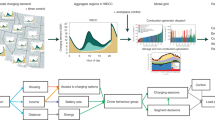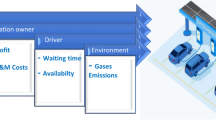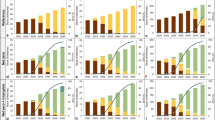Abstract
Major technological advancements and recent policy support are improving the outlook for heavy-duty truck electrification in the United States. In particular, short-haul operations (≤200 miles (≤322 km)) are prevalent and early candidates for plug-in electric vehicles (EVs) given their short, predictable routes and return-to-base applications, which allows vehicles to recharge when off shift at their depots. Although previous studies investigated the impacts of added electrical loads on distribution systems, which included light-duty EVs, the implications for heavy-duty EV charging are underexplored. Here we summarize the causes, costs and lead times of distribution system upgrades anticipated for depot charging. We also developed synthetic depot charging load profiles for heavy-duty trucks from real-world operating schedules, and found that charging requirements are met at common light-duty EV charging rates (≤100 kW per vehicle). Finally, we applied depot charging load profiles to 36 distribution real-world substations, which showed that most can accommodate high levels of heavy-duty EV charging without upgrades.
This is a preview of subscription content, access via your institution
Access options
Access Nature and 54 other Nature Portfolio journals
Get Nature+, our best-value online-access subscription
$29.99 / 30 days
cancel any time
Subscribe to this journal
Receive 12 digital issues and online access to articles
$119.00 per year
only $9.92 per issue
Buy this article
- Purchase on Springer Link
- Instant access to full article PDF
Prices may be subject to local taxes which are calculated during checkout







Similar content being viewed by others
Data availability
The fleet depot charging load profiles and EV load integration results generated in this study are available through the NREL Data Catalog at https://data.nrel.gov/submissions/162. The vehicle drive cycles used in this study contain business-sensitive geographical information and thus are not publicly available; however, anonymized data summaries and visualizations are available through the Fleet DNA website at https://www.nrel.gov/transportation/fleettest-fleet-dna.html.
Code availability
Derived fleet-charging availability schedules, daily vehicle mileage and energy requirements, and the code developed to produce, study and visualize fleet load profiles, are open source and available at https://github.com/NREL/hdev-depot-charging-2021.
References
Global EV Outlook 2020 (International Energy Agency, 2020); https://www.iea.org/reports/global-ev-outlook-2020
Muratori, M. et al. The rise of electric vehicles—2020 status and future expectations. Prog. Energy 3, 022002 (2021).
Transportation Sector Energy Use by Mode and Type (US Energy Information Administration, 2020); https://www.eia.gov/outlooks/aeo/data/browser/#/?id=45-AEO2020&sourcekey=0
Brown, A. L., Fleming, K. L. & Safford, H. R. Prospects for a highly electric road transportation sector in the USA. Curr. Sustain./Renew. Energy Rep. 7, 84–93 (2020).
Williams, N. & Murray, D. An Analysis of the Operational Costs of Trucking: 2020 Update (American Transportation Research Institute, 2020); https://truckingresearch.org/wp-content/uploads/2020/11/ATRI-Operational-Costs-of-Trucking-2020.pdf
Thomas, J. Drive cycle powertrain efficiencies and trends derived from EPA vehicle dynamometer results. SAE Int. J. Passeng. Cars Mech. Syst. 7, 1374–1384 (2014).
Borlaug, B., Salisbury, S., Gerdes, M. & Muratori, M. Levelized cost of charging electric vehicles in the United States. Joule 4, 1470–1485 (2020).
Phadke, A., McCall, M. & Rajagopal, D. Reforming electricity rates to enable economically competitive electric trucking. Environ. Res. Lett. 14, 124047 (2019).
Moore, J. & Bullard, N. BNEF Executive Factbook: Power, Transport, Buildings and Industry, Commodities, Food and Agriculture, Capital (BloombergNEF, 2020).
Çabukoglu, E., Georges, G., Küng, L., Pareschi, G. & Boulouchos, K. Battery electric propulsion: an option for heavy-duty vehicles? Results from a Swiss case-study. Transport. Res. C 88, 107–123 (2018).
Freight Transportation Energy Use (US Energy Information Administration, 2020); https://www.eia.gov/outlooks/aeo/data/browser/#/?id=58-AEO2020&cases=ref2020&sourcekey=0
Zhang, H., Chen, W. & Huang, W. TIMES modelling of transport sector in China and USA: comparisons from a decarbonization perspective. Appl. Energy 162, 1505–1514 (2016).
Muratori, M. et al. Role of the freight sector in future climate change mitigation scenarios. Environ. Sci. Technol. 51, 3526–3533 (2017).
Kaack, L. H., Vaishnav, P., Morgan, M. G., Azevedo, I. L. & Rai, S. Decarbonizing intraregional freight systems with a focus on modal shift. Environ. Res. Lett. 13, 083001 (2018).
Yeh, S. et al. Detailed assessment of global transport-energy models’ structures and projections. Transport. Res. D 55, 294–309 (2016).
Moultak, M., Lutsey, N. & Hall, D. Transitioning to Zero-Emission Heavy-Duty Freight Vehicles (International Council on Clean Transportation, 2017); https://theicct.org/publications/transitioning-zero-emission-heavy-duty-freight-vehicles
Mareev, I., Becker, J. & Sauer, D. U. Battery dimensioning and life cycle costs analysis for a heavy-duty truck considering the requirements of long-haul transportation. Energies 11, 55 (2018).
Sripad, S. & Viswanathan, V. Performance metrics required of next-generation batteries to make a practical electric Semi truck. ACS Energy Lett. 2, 1669–1673 (2017).
Davis, S. C. & Boundy, R. G. Transportation Energy Data Book Edition 38.1 (Oak Ridge National Laboratory, 2020); https://tedb.ornl.gov
Knopp, M. The Consolidated Appropriations Act, 2019, Truck Size and Weight Provisions (US Department of Transportation Federal Highway Administration, 2019); https://ops.fhwa.dot.gov/freight/pol_plng_finance/policy/fastact/tswprovisions2019/index.htm
2002 Vehicle Inventory and Use Survey (United States Census Bureau, 2004); https://www.census.gov/library/publications/2002/econ/census/vehicle-inventory-and-use-survey.html
Hooper, A. & Murray, D. E-Commerce Impacts on the Trucking Industry (American Transportation Research Institute, 2019); https://truckingresearch.org/wp-content/uploads/2019/02/ATRI-Impacts-of-E-Commerce-on-Trucking-02-2019.pdf
Young, S. & Caesar, K. California Takes Bold Step to Reduce Truck Pollution (California Air Resources Board, 2020); https://ww2.arb.ca.gov/news/california-takes-bold-step-reduce-truck-pollution
Multi-State Medium- and Heavy-Duty Zero Emission Vehicle Memorandum of Understanding (E&E News, 2019); https://www.eenews.net/assets/2020/06/26/document_cw_01.pdf
Drive to Zero’s Zero-Emission Technology Inventory (ZETI) Tool Version 5.5 (CALSTART, 2020); https://globaldrivetozero.org/tools/zero-emission-technology-inventory/
Tesla Semi (Tesla, 2021); https://www.tesla.com/semi
Nikola Tre (Nikola Motor Company, 2021); https://nikolamotor.com/tre
eCascadia (Freightliner Trucks, 2021); https://freightliner.com/trucks/ecascadia/
Kenworth Trucks—The World’s Best (Kenworth, 2020); https://www.kenworth.com/about-us/news/t680e/
Volvo Trucks North America Announces Launch of VNR Electric Model in United States, Canada (Volvo, 2020); https://www.volvotrucks.us:443/news-and-stories/press-releases/2020/november/volvo-trucks-north-america-announces-launch-of-vnr-electric-model-in-united-states/
Mercedes-Benz eActros: Heavy-Duty Electric Truck (Mercedes-Benz, 2021); https://www.mercedes-benz.com/en/vehicles/trucks/eactros-heavy-duty-electric-truck/
O’Dea, J. Ready for Work: Now is the Time for Heavy-Duty Electric Vehicles (Union of Concerned Scientists, 2019); https://www.ucsusa.org/resources/ready-work
Earl, T. et al. Analysis of Long Haul Battery Electric Trucks in EU: Marketplace and Technology, Economic, Environmental, and Policy Perspectives (European Federation for Transport and Environment, 2018).
Sen, B., Ercan, T. & Tatari, O. Does a battery-electric truck make a difference?—Life cycle emissions, costs, and externality analysis of alternative fuel-powered class 8 heavy-duty trucks in the United States. J. Clean. Prod. 141, 110–121 (2017).
Electric Trucks’ Contribution to Freight Decarbonisation (Transport & Environment, 2017); https://www.transportenvironment.org/sites/te/files/publications/2017_09_Update_Norway_study_final.pdf
A. Phadke et al. Why Regional and Long-Haul Trucks are Primed for Electrification Now (Lawrence Berkeley National Laboratory, 2021).
McCall, M. & Phadke, A. California Semi Truck Electrification: Preliminary Assessment of Infrastructure Needs and Cost–Benefit Analysis (Lawrence Berkeley National Laboratory, 2019).
Jadun, P. et al. Electrification Futures Study: A Technical Evaluation of the Impacts of an Electrified US Energy System (National Renewable Energy Laboratory, 2017).
Tryggestad, C. et al. New Reality: Electric Trucks and Their Implications on Energy Demand (McKinsey Energy Insights, 2017); https://www.mckinseyenergyinsights.com/insights/new-reality-electric-trucks-and-their-implications-on-energy-demand/
US Electric Truck Sales Set to Increase Exponentially by 2025 (Wood Mackenzie, 2020); https://www.woodmac.com/press-releases/us-electric-truck-sales-set-to-increase-exponentially-by-2025/
Truck Fleet and Operations (Federal Highway Administration, 1997); https://www.fhwa.dot.gov/reports/tswstudy/Vol2-Chapter3.pdf
Electric Trucks: Where They Make Sense (North American Council for Freight Efficiency, 2018); https://nacfe.org/emerging-technology/electric-trucks/
Comparison of Medium- and Heavy-Duty Technologies in California (California Electric Transportation Coalition, 2019).
Fleet DNA Project Data (National Renewable Energy Laboratory, accessed 2 March 2020); www.nrel.gov/fleetdna
Hallmark, S. & Lamptey, S. Evaluation of Different Methods to Calculate Heavy-Truck VMT (Midwest Transportation Consortium, 2004).
Usman, M. et al. A coordinated framework for optimized charging of EV fleet in smart grid. Procedia Comput. Sci. 94, 332–339 (2016).
Frendo, O. et al. Data-driven smart charging for heterogeneous electric vehicle fleets. Energy AI 1, 100007 (2020).
Summary Report on EVs at Scale and the US Electric Power System (US Drive, 2019).
Nelder, C. & Rogers, E. Reducing EV Charging Infrastructure Costs (Rocky Mountain Institute, 2019); https://rmi.org/insight/reducing-ev-charging-infrastructure-costs/
Analysis & Information Online—Motor Carrier Analysis and Information Reviews by Fleet Size (US Department of Transportation Federal Motor Carrier Safety Administration, 2021); https://ai.fmcsa.dot.gov/SafetyProgram/spRptReview.aspx?rpt=RVFS
MarketInsight: Registrations and Vehicles-in-Operation (IHS Markit, 2013); https://ihsmarkit.com/products/automotive-market-data-analysis.html
Saleh, F. et al. Impact of electric vehicles on distribution substations: a Swiss case study. Appl. Energy 137, 88–96 (2015).
Gonzalez, F., Petit, M. & Perez, Y. Impact of non-systematic electric vehicle charging behaviour on a distribution substation. 2019 IEEE PES Smart Grid Technologies Europe (IEEE, 2019); https://doi.org/10.1109/ISGTEurope.2019.8905710
Dubey, A. & Santoso, S. Electric vehicle charging on residential distribution systems: impacts and mitigations. IEEE Access 3, 1871–1893 (2015).
Bohn, T. Multi-port, 1+ MW Charging System for Medium- and Heavy-Duty EVs: What We Know and What Is on the Horizon? (Argonne National Laboratory, 2020).
CharIN e.V. Perspective on Standardization Developments (International Transport Forum, 2020); https://www.itf-oecd.org/sites/default/files/docs/charging-infrastructure-standardisation-developments-bracklo.pdf
Lingeman, J. Musk now says 621 miles of range for Tesla Semi. Autoweek (25 November 2020); https://www.autoweek.com/news/green-cars/a34774933/musk-now-says-621-miles-of-range-for-tesla-semi/
Stith, P. NIA–NASA Urban Air Electric Infrastructure Study (Black & Veatch, 2020).
Infrastructure Needs Assessment for 5M Light-Duty Vehicles in California by 2030 (California Electric Transportation Coalition, 2020).
Pacific Gas and Electric Company’s Unit Cost Guide (Pacific Gas & Electric, 2019); https://www.pge.com/pge_global/common/pdfs/for-our-business-partners/interconnection-renewables/Unit-Cost-Guide.pdf
Southern California Edison Unit Cost Guide (Southern California Edison, 2019); https://www.sce.com/sites/default/files/inline-files/Attachment%20A%20-%20Unit%20Cost%20Guide%202019.pdf
Horowitz, K. 2019 Distribution System Upgrade Unit Cost Database Current Version (National Renewable Energy Laboratory, 2019); https://doi.org/10.7799/1491263
Francfort, J., Garetson, T., Karner, D., Salisbury, S. D. & Smart, J. G. Considerations for Corridor and Community DC Fast Charging Complex System Design (Idaho National Laboratory, 2017); https://doi.org/10.2172/1484708
Transmission Cost Estimation Guide (Midcontinent Independent System Operator, 2019); https://cdn.misoenergy.org/20200211%20PSC%20Item%2005c%20Cost%20Estimation%20Guide%20for%20MTEP20%20DRAFT%20Redline425617.pdf
Nicholas, M. Estimating Electric Vehicle Charging Infrastructure Costs Across Major US Metropolitan Areas (The International Council on Clean Transportation, 2019); https://theicct.org/sites/default/files/publications/ICCT_EV_Charging_Cost_20190813.pdf
Drouglazet, K. Tesla Semi: ce qu’il faut savoir sur le camion électrique semi-autonome de Tesla. L’Usine Digitale (17 November 2017); https://www.usine-digitale.fr/article/tesla-semi-ce-qu-il-faut-savoir-sur-le-camion-electrique-semi-autonome-de-tesla.N615453
A Guide to Understanding Battery Specifications (MIT Electric Vehicle Team, 2008); http://web.mit.edu/evt/summary_battery_specifications.pdf
Efron, B., Rogosa, D. & Tibshirani, R. in International Encyclopedia of the Social & Behavioral Sciences (eds Smelser, N. J. & Baltes, P. B.) 13216–13220 (Elsevier, 2004).
Acknowledgements
This work was authored in part by the NREL, operated by Alliance for Sustainable Energy, LLC, for the US Department of Energy (DOE) under Contract no. DE-AC36-08GO28308. Funding provided by the US Department of Energy Office of Energy Efficiency and Renewable Energy Vehicle Technologies Office. The views expressed in the article do not necessarily represent the views of the DOE or the US Government. The US Government and the publisher, by accepting the article for publication, acknowledges that the US Government retains a non-exclusive, paid-up, irrevocable, worldwide license to publish or reproduce the published form of this work, or allow others to do so, for US Government purposes. We are grateful to DOE programme managers J. Ward and H. Croteau for their guidance and support. We also acknowledge E. Miller (NREL) and NREL’s FleetDNA team for assistance with accessing and analysing fleet operating data. A. Fowler and R. Shipman (Oncor) both contributed to the execution of the case study. Finally, A. Meintz (NREL), A. Birky (NREL), P. Bean (Tesla) and M. Neumann (Tesla) provided helpful comments and insights that improved the study.
Author information
Authors and Affiliations
Contributions
M.M. and B.B. conceptualized the study. M.M., B.B., M.G., D.W. and T.C. provided the methodology. B.B. and D.W. created the software and carried out the formal analysis and visualization. All the authors performed data curation and took part in consultation. The original draft was written by B.B., M.M., M.G. and D.W., with review and editing by B.B. and M.M. Funding acquisition was by M.M., who supervised the study.
Corresponding author
Ethics declarations
Competing interests
D.W. and W.M. are employees of Oncor Electric Delivery Co. and T.C., A.I., H.G. and C.M. are employees of Southern Company. The other authors declare no competing interests.
Additional information
Peer review information Nature Energy thanks Heikki Liimatainen, Moataz Mohamed and the other, anonymous, reviewer(s) for their contribution to the peer review of this work.
Publisher’s note Springer Nature remains neutral with regard to jurisdictional claims in published maps and institutional affiliations.
Supplementary information
Supplementary Information
Supplementary Notes 1–3, Figs. 1–8, Tables 1 and 2, and references.
Rights and permissions
About this article
Cite this article
Borlaug, B., Muratori, M., Gilleran, M. et al. Heavy-duty truck electrification and the impacts of depot charging on electricity distribution systems. Nat Energy 6, 673–682 (2021). https://doi.org/10.1038/s41560-021-00855-0
Received:
Accepted:
Published:
Issue Date:
DOI: https://doi.org/10.1038/s41560-021-00855-0
This article is cited by
-
Decarbonising road freight transport: The role of zero-emission trucks and intangible costs
Scientific Reports (2024)
-
A cross-scale framework for evaluating flexibility values of battery and fuel cell electric vehicles
Nature Communications (2024)
-
Trade-off between critical metal requirement and transportation decarbonization in automotive electrification
Nature Communications (2023)
-
A resilient battery electric bus transit system configuration
Nature Communications (2023)
-
Battery aging-minimal speed control of autonomous heavy-duty electric trucks in adaptation to highway topography and traffic
Science China Technological Sciences (2023)



